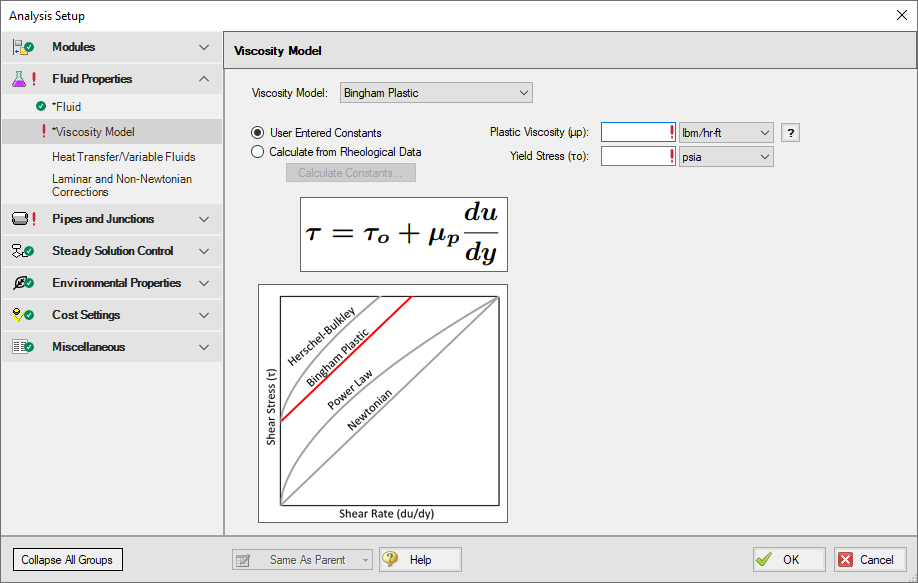Bingham Plastic Model
The Bingham Plastic model for non-Newtonian fluids is one of the most common viscosity models used in hydraulic analysis. This model states that the shear rate resulting from a given shear stress applied to the fluid can be described with the following piecewise equation:
Where du/dy is the shear rate (or velocity gradient), τ is the applied shear stress, τo is the yield stress, and μ∞ is the plastic viscosity or coefficient of rigidity.
The Bingham Plastic model describes η, the apparent viscosity of the fluid as:
The Bingham Plastic model uses a constant value for plastic viscosity, meaning a value for μ∞ of 0 would result in a Newtonian fluid. Some fluids may see Bingham Pseudoplastic behavior, where shear stress and shear rate do not have a linear relationship. These fluids can be modeled using the Herschel-Bulkley viscosity model.
To employ this model, users must have values for τo and μ∞, or have rheological test data.
Bingham Plastic Interface
The Viscosity Model panel appears as shown below in Figure 1 when the Bingham Plastic model is selected.

Figure 1: Viscosity Model panel for the Bingham Plastic model
Users must enter values for the Bingham Plastic constants, μ∞ and τo. If the user has raw rheological test data instead, they can enter that directly using the Calculate from Rheological Data option instead.
Theory and Correlations
AFT Fathom models the frictional losses due to a Bingham Plastic fluid using correlations taken from DarbyDarby, R., Chemical Engineering Fluid Mechanics, 2nd edition, Marcel Dekker, New York, NY, 2001. , pg. 168-169. Note that the original equations in Darby use the Fanning friction factor, while AFT software uses the Moody friction factor. The equations below have been modified from the original accordingly.
Where:
The Reynolds number for a Bingham Plastic fluid is defined as:
The Hedstrom number for a Bingham Plastic fluid is defined as:
The friction factor calculated using this correlation is then used to determine pressure loss following Equation 3 in the Network Solution Methodology topic.
These correlations are valid across the full range of Reynolds number. The applicability of this method to highly turbulent flow is limited only by the test data used to determine the Bingham Plastic constants.
Related Topics
Duffy Method (Pulp and Paper Stock)
Brecht & Heller Method (Pulp and Paper Stock)
Related Examples
Related Blogs
Non-Newtonian Fluids - How to Model the Soap, Silly-Putty, or Shampoo in Your Pipe Network



